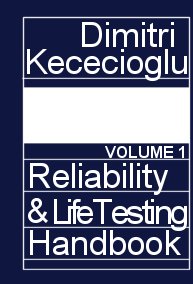
Reliability and Life Testing Handbook, Vol. 1
Toolkit Home
Comments/Questions:


reliabilityanalytics.com
References:
- MIL-HDBK-189 Base, Reliability Growth Management (13 Feb 1981).
- MIL-HDBK-189C, Reliability Growth Management (14 Jun 2011).
- MIL-HDBK-781, Reliability Test Methods, Plans, and Environments for Engineering Development, Qualification, and Production (14 Jul 1987).
- RADC-TR-84-20, Reliability Growth Testing Effectiveness.
- Pecht, Michael (Editor) Product Reliability, Maintainability, and Supportability Handbook.
- Smith, David J. Reliability, Maintainability and Risk: Practical Methods for Engineers.
Privacy Policy
All content and materials on this site are provided "as is" Reliability Analytics makes no warranty, express or implied, including the warranties of merchantability and fitness for a particular purpose; nor assumes any legal liability or responsibility for the accuracy, completeness, or usefulness of any information, apparatus, product, or process disclosed; nor represents that its use would not infringe privately owned rights.

